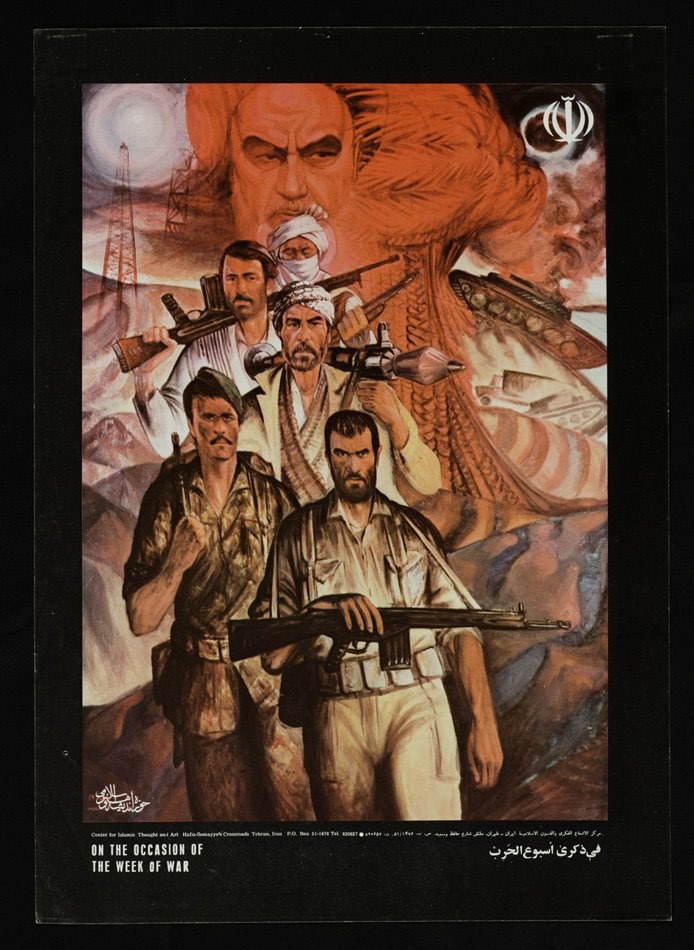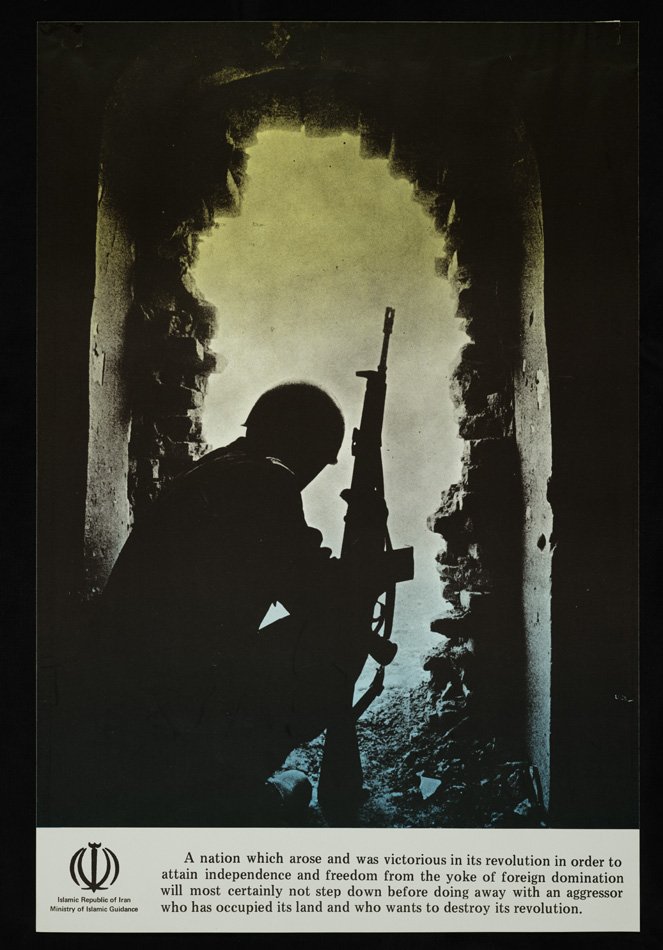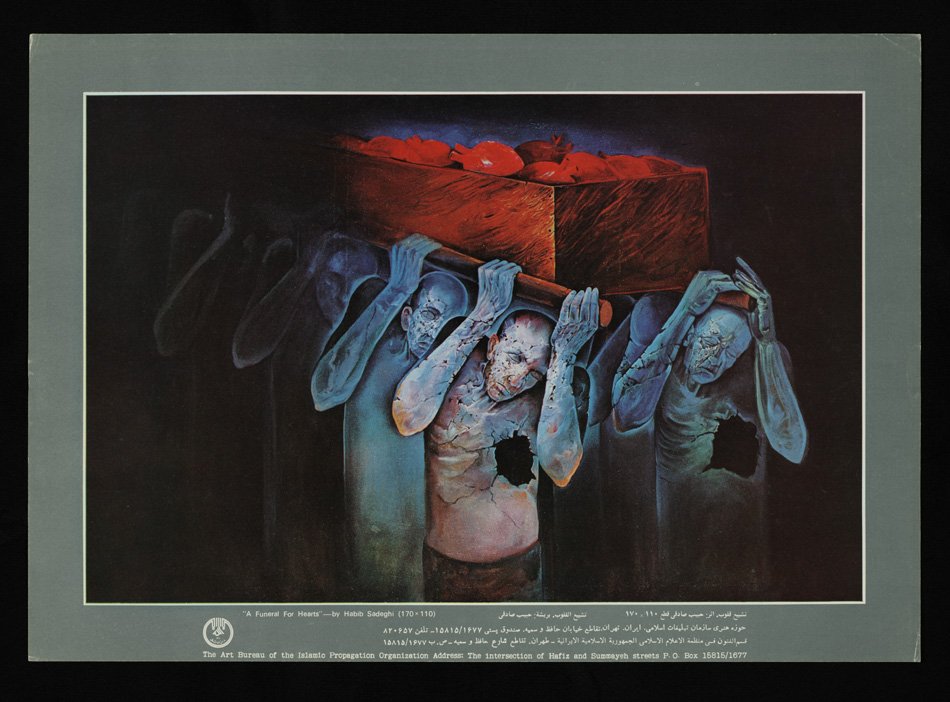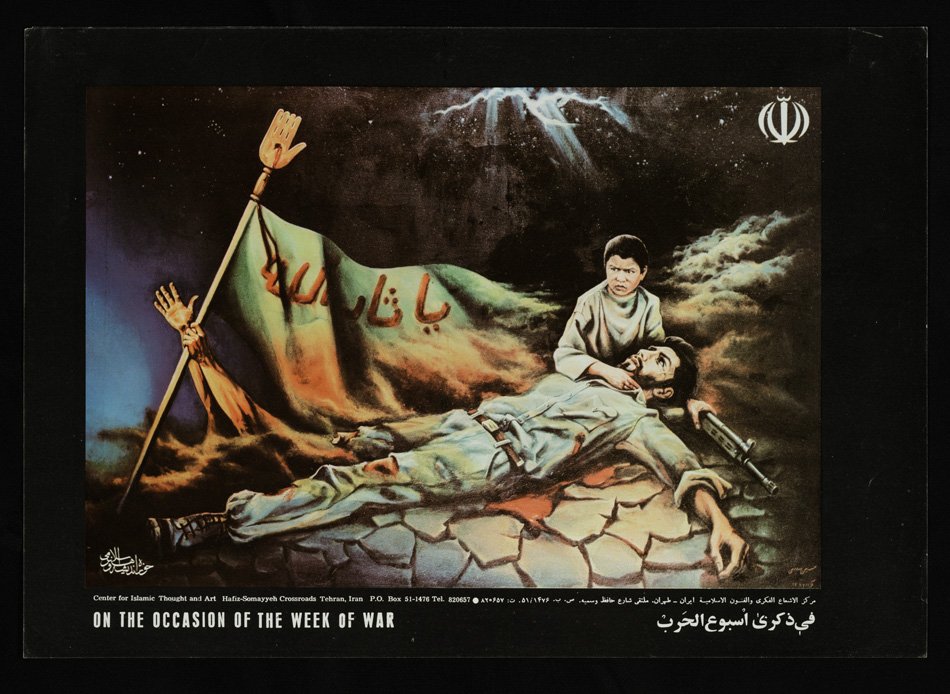The Holy Defense
Marked by chemical weapons and human-wave assaults, the Iran-Iraq War (1980-88) was one of the deadliest wars of the twentieth century. The struggling and militarily weak Islamic Republic faced the existential threat of Iraqi invasion on the heels of the Revolution.
In order to mobilize public opinion and encourage military enlistment, the Iranian government deployed an immense visual output in support of the war effort. The contribution of every Iranian—young and old, male and female—was emphasized as necessary in the defense against Iraqi aggression.
For these reasons, and despite Iranian incursions into Iraq and an eventual stalemate, the Iran-Iraq War was known as the “Imposed War” and the “Holy Defense” within Iran. The Islamic Republic stressed its moral superiority by couching its military engagements (both defensive and offensive) as a sacred, collective effort to protect the Iranian homeland and ensure its survival.
ca. 1980s
Kazim Chalipa, Iranian, b. 1957
Middle Eastern Posters Collection
Box 3, Poster 70
Five Iranian soldiers, of various ethnicities and representing different branches of the military, march across a desert battlefield in the war-torn province of Khuzestan. The red specter of Ayatollah Khomeini watches over the various scenes of war, including tank maneuvers. Marching in single file towards the viewer, the soldiers (and their different cultural backgrounds) are united and safeguarded by Khomeini as they walk past oil fields that are set ablaze.
ca. 1980's
Middle Eastern Posters Collection,
Box 3, Poster 62
In this poster a soldier sits on the lookout in a bombed-out building, the yellow air outside indicating the use of a deadly chemical weapon. Hundreds of thousands of Iranian soldiers were either killed or permanently disabled by Saddam Hussein's use of chemical warfare during the Iran-Iraq War. The quoted English text informs the viewer that despite such brutal attacks Iran will never surrender.
ca. 1980
Habib Sadeqi, Iranian, b. 1957
Middle Eastern Posters Collection
Box 3, Poster 124
In this painting, figures in a funeral procession grimly carry a coffin filled to the brim with their own hearts. The artist Sadeqi portrays the marchers' heads being slowly crushed into their bodies, which begin to crack and disintegrate away from the empty hollow in their chests. The painting presents us with a deeply stirring depiction of the physical tolls and emotional burdens Iranians have endured through both the 1979 Revolution and the Iran-Iraq War.
1980
Middle Eastern Posters Collection
Box 3, Poster 74
Rather than shy away from the grim realities of war, this poster positions them within a continuation of the devastating Battle of Karbala. Two disembodied arms rise up from the ground carrying a flag that pledges the vengeance of God (Ya thar Allah). The martyrs of Karbala are rising up to claim the newest martyr from the very same battlefield on which they died. Time between the 7th-century battle and the ongoing Iran-Iraq War is thus effectively collapsed. The poster depicts the threshold of death as the transitional moment in which soldiers join their fellow martyrs in paradise.
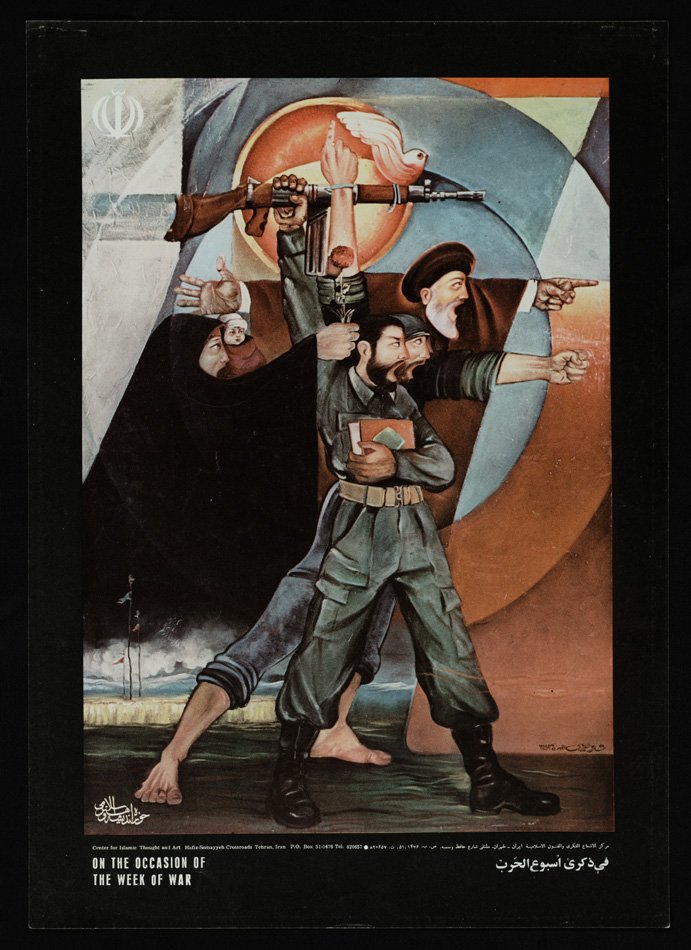
1980
Husayn Khusrawjirdi, Iranian, b. 1957
Middle Eastern Posters Collection
Box 3, Poster 72
This Socialist-Realist montage unites archetypal figures from the war: the religious cleric, soldiers, and a mother. The mother carries an infant in one arm and holds with her other a red tulip: the former represents new life, and the latter death and self-sacrifice. In one of the soldier's arms appears a book, most likely a copy of the Qur'an. His other arm thrusts a rifle up into the air, upon which sits a dove (representative of a martyr's soul). The woman is depicted wearing a traditional chador, illustrating the Islamic Republic's desire to represent Iranian women as religiously devout. These members of society played important roles in both the Revolution and the Iran-Iraq War, and thus are depicted as a united front working together for the future of Iran.
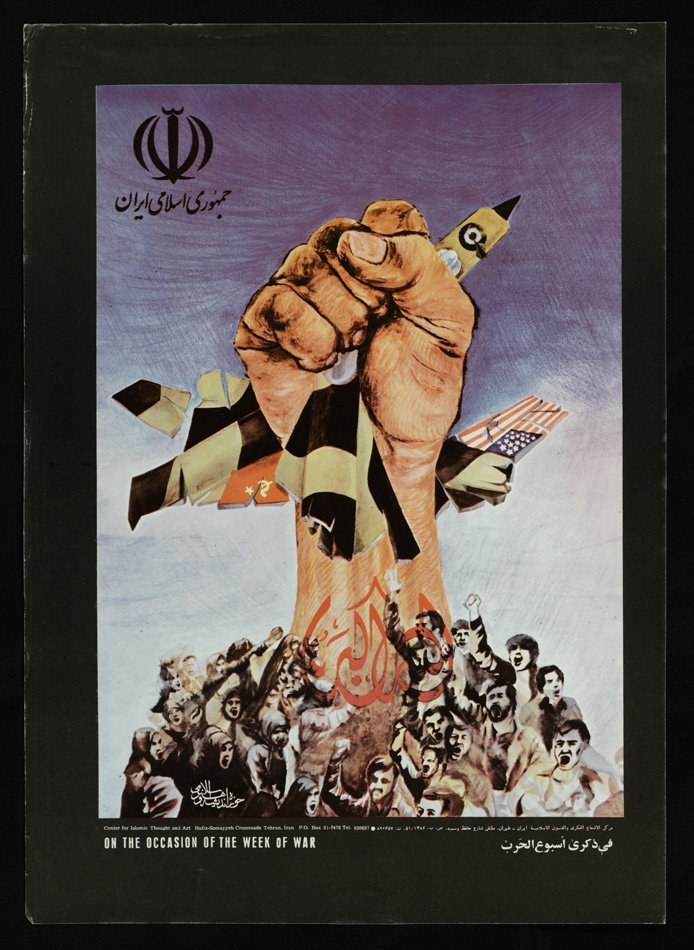
ca. 1980s
Middle Eastern Posters Collection
Box 3, Poster 68
Rising up from a crowd of Iranian protestors, a large fist crushes an Iraqi jet in a symbolic act of defiance and projected victory during Iran's war with Iraq. The jet is emblazoned with the flags of the USSR and the United States, further rejecting the interference of foreign powers in the newly established Islamic Republic.
The fist is found in the visual propaganda of other revolutions of the 20th century. The poster's artist thus symbolically aligns Iranian mass mobilization with this widely recognizable symbol of defiance. The unity of the Iranian people during the Revolution, and now against their Iraqi enemy, is depicted as the root cause of political triumph and military success.
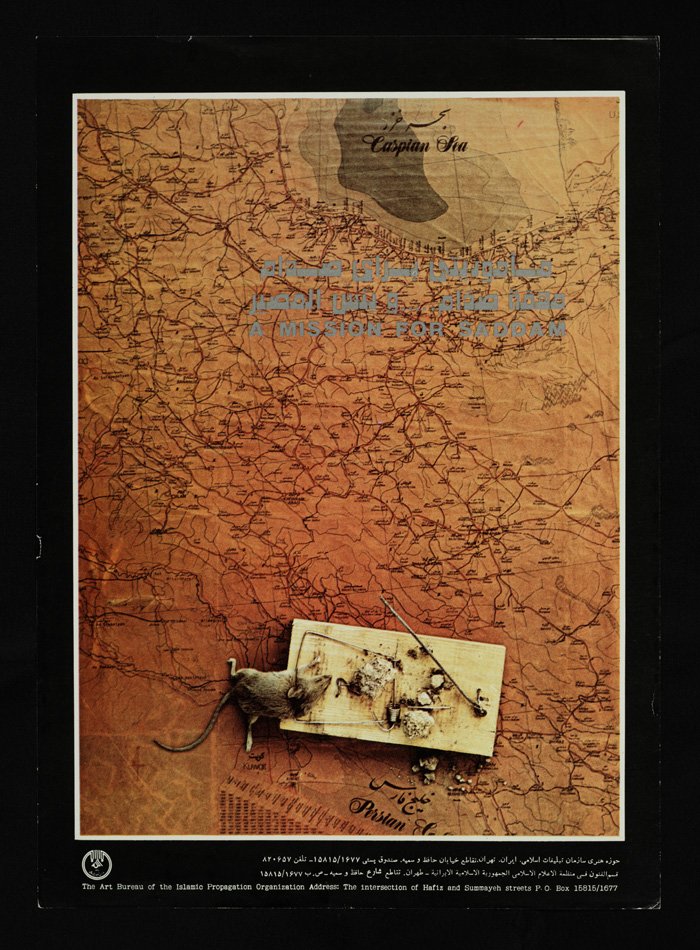
ca. 1980
Middle Eastern Posters Collection
Box 3, Poster 120
In this poster a mouse trap sits on top of a map of Iran. The dead mouse, caught in the trap, suggests that if Saddam Hussein were to invade Iran his forces would be easily defeated. Although Iran describes the Iran-Iraq War as the "Imposed War," both countries were equally involved in extending the conflict. Both countries sought to become the main power in the region, and conflicts over their shared border endured, with Iran wishing to extend its southern border to encompass the Shi'i holy cities of Najaf and Karbala and Iraq aiming to secure the Shatt al-Arab waterway. The artist Zargham's inclusion of an extensive map of Iran may be a subtle reference to these geo-political disputes that served the greater ambitions of both nations to become the dominant power in the region.
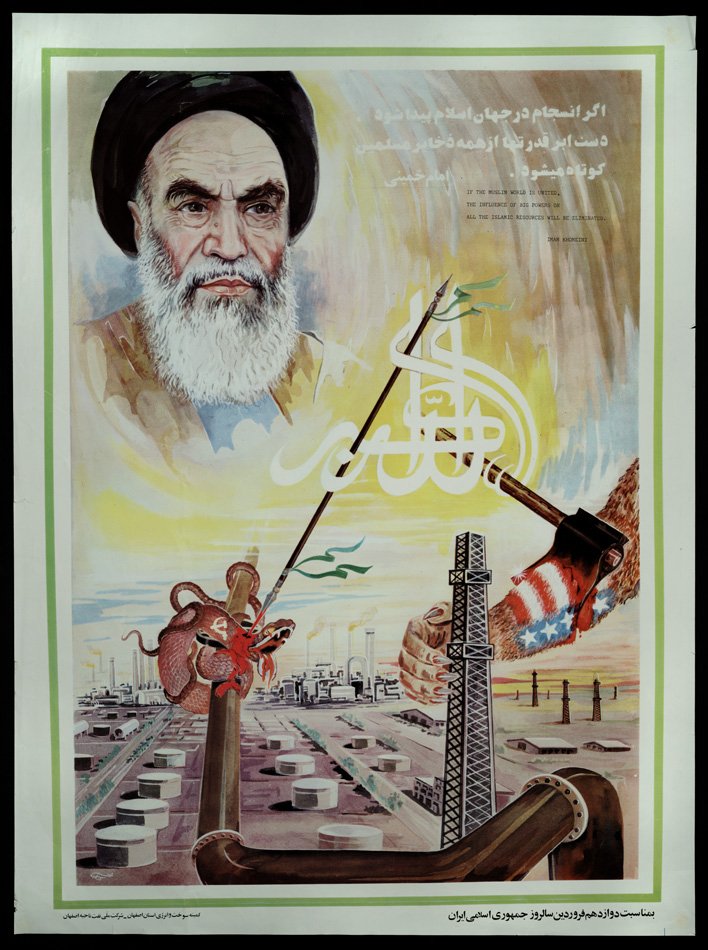
ca. 1980s
Middle Eastern Posters Collection
Box 4, Poster 198
In this poster, an oil facility lies beneath a large portrait of Ayatollah Khomeini. A serpent (impressed with the Soviet hammer and sickle) sits coiled around an oil pipe as it is impaled by a spear. At the same time, an axe chops off the lower arm of a beast marked with the flag of the United States. Both weapons are wrapped within the radiant proclamation that "God is Great." To the right of Khomeini's portrait is his saying: "If the Muslim world is united, the influence of big powers on all Islamic resources will be eliminated." Iran's history of foreign interference in its own governance (particularly Britain's control of the oil industry under the Pahlavis) resulted in fears after the Revolution of further incursion from the United States, Britain, and the Soviet Union. Khomeini's god-like presence alongside weapons emanating from the name of God illustrates the belief that the Islamic faith can overcome the foreign theft of Iran's natural resources.
